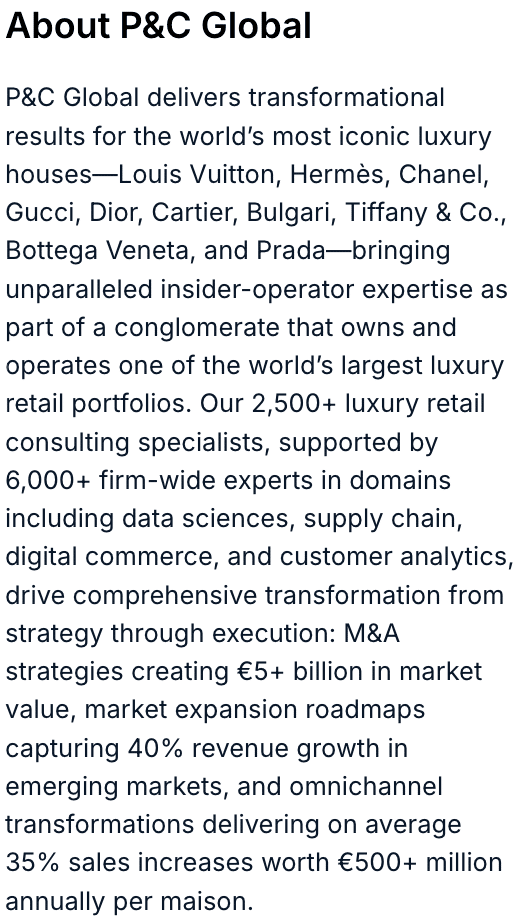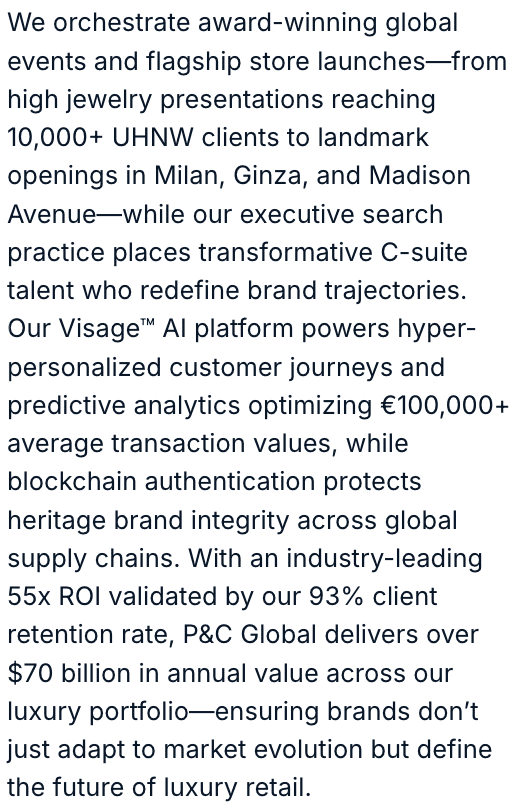Omnichannel Journeys, Immersive Retail, Culture & Lifestyle Loyalty
Even as growth slows, China’s luxury market continues to shape what resonance, exclusivity, and experience mean in a post-boom world. High-net-worth (HNW) consumers in China are not retreating from luxury; they’re redefining it. Prestige built on celebrity, mass visibility, and legacy is no longer enough to captivate China’s elite. Brands that succeed in China today are mastering a new language: one of high-touch ecosystems with speed and operational excellence, immersive brand environments, deep cultural fluency, and lifestyle alignment.
With a fast-adapting, digitally native HNW population, China continues to drive innovation in how luxury is defined, delivered, and felt. Real estate, wellness, and experiential spending, alongside mounting competition from local prestige brands, has exposed vulnerabilities in Western legacy strategies while also offering a path toward reinvention. Today’s Chinese luxury consumers are more selective than ever, shifting beyond status signaling to prioritize intrinsic value, cultural authenticity, and personal meaning. The pursuit of luxury is no longer just about the label, but about what it says, what it enables, the speed of delivery, and how it aligns with identity.
This article explores key innovations flourishing in China’s luxury landscape, from immersive, culturally embedded retail environments to exclusive, hyper personalized experiences that foster deep brand loyalty. It offers critical lessons for Western brands navigating a market increasingly defined by meaning, operational excellence, and deeper client connection.
Understanding China’s Distinct Luxury Landscape
In the wake of COVID, China’s luxury consumers, long fluent in digital platforms, are rebalancing their expectations. While digital still plays a key role in discovery and convenience, physical engagement has regained primacy, especially when it delivers exclusivity, trust, and sensory depth.
Luxury in China remains fast and fluid, but is now increasingly defined by operational excellence, cultural nuance, and emotional connection. The buyer journey must be truly omnichannel, integrating digital ease with tactile, in-store immersion. E-commerce must provide not only speed, but certainty, with a typical maximum 2–3-day fulfillment and clearly guaranteed delivery timelines. Retail spaces, meanwhile, must transcend function to become curated sanctuaries of storytelling, service, and identity.
What’s Changing in China’s Luxury Market
These four shifts reflect the operational, cultural, and experiential transformations redefining luxury in China today, offering Western brands a roadmap for future relevance and success.
From | To | Description |
Digital Spectacle | Frictionless Omnichannel Journeys | From flashy super app integrations to high-touch ecosystems that deliver consistency, fulfillment speed, and trust across all channels |
Retail Boutiques | Immersive Brand Worlds | From transactional retail spaces to cultural destinations with art, dining, and architectural storytelling |
Heritage Value | Cultural Relevance | From superficial culture cues to deeply embedded narratives co-created with Chinese traditions |
Product-Centric Loyalty | Lifestyle Integration | From marketing programs to emotionally intelligent ecosystems that reflect client identity and values |
This evolution marks more than a shift in consumer behavior—it signals a wholesale redefinition of luxury itself. For China’s luxury clientele, traditional indicators of prestige are no longer sufficient. What matters now is how a brand fulfills its order promises, aligns with identity, and delivers meaning across every touchpoint.
Deliver Frictionless Omnichannel Journeys, Not Digital Spectacle
Strategic Insight: Super apps still play a role, but only as part of a broader, integrated system that delivers certainty, speed, and service.
While digital platforms remain indispensable tools, they are no longer silver bullets for luxury success in China. The novelty of super app integration has faded. Performance now hinges on how well digital and physical channels work together. Consumers expect the same premium service across platforms, whether booking a store appointment, browsing a capsule collection, or arranging home delivery.
Today’s luxury buyer in China judges brands on speed, fulfillment reliability, and the seamlessness of their experience. Brands that over-index on digital innovation at the expense of real-world execution risk eroding trust.
Best Practices
- Linking promotions or exclusive drops to reliable fulfillment systems with guaranteed delivery windows, establishing trust before the transaction even begins.
- Using digital CRM and clienteling platforms to promote logistics transparency, helping HNW clients track service and delivery with confidence.
- Embedding store-based services (appointments, concierge) into digital tools such as WeChat mini-programs, Xiaohongshu campaigns, or Tmall flagship portals, ensuring a seamless, high-touch experience across both online and offline channels.
Creating Immersive Brand Worlds
Strategic Insight: China’s affluent consumers are returning to the physical world in search of trust, intimacy, and multisensory engagement. The flagship store is no longer a retail endpoint, rather they are cultural destinations that build trust and connection.
As consumer enthusiasm for livestreaming and digital-only campaigns shifts, flagship stores are experiencing a renaissance. For luxury consumers in China, physical spaces now offer something rare: trust, texture, and tactility. In a world of scrollable content, the flagship delivers what screens cannot: emotional immersion and sensory connection.
More than displaying inventory, today’s best flagship concepts narrate identity, restore confidence in brand values, and enable personalized engagement that cannot be replicated online. They serve as strategic platforms for brand storytelling, cultural alignment, and localized prestige.
These immersive brand worlds are carefully designed to evoke luxury lifestyles, encourage lingering, and create social capital. Incorporating elements like curated dining spaces, private client lounges, art installations, and architecture inspired by local heritage, these destinations transform luxury from product to performance.
Key Design Strategies
- Multi-use zones: Event venues, galleries, and culinary spaces extend the visit beyond transaction.
- Localized narrative cues: Architecture and interior design that nod to regional history or craftsmanship build cultural credibility.
- VIP sanctuaries: Discreet rooms, appointment-only access, and ultra-personalized services deliver the exclusivity luxury clients expect.
- Social shareability: Aesthetic vignettes, sharable moments, and artist collaborations amplify online engagement through authentic, user-generated storytelling.
Example:
- In Shanghai, “The Louis” concept store, shaped like an ocean liner, pays homage to both the maison’s nautical heritage and Shanghai’s maritime legacy. Over 1,200 square meters of curated space features immersive exhibitions, localized dining experiences, and multi-use event zones. Far from a conventional brick-and-mortar space, it serves as a cultural embassy, where architecture, identity, and place converge.
This groundbreaking concept transforms the luxury shopping experience and reinforces the brand’s identity as a cultural institution, where artistry, innovation, and heritage seamlessly intersect. More than a retail destination, this type of flagship is a tangible embodiment of the brand’s mythology, purpose-built for modern luxury consumers who crave intimacy over impression, substance over scale, and human-centered design over hyper-digital spectacle.
Cultural Relevance by Design
Strategic Insight: The era of superficial or color-coded brand gestures is over. For luxury brands in China, true cultural resonance stems from upstream immersion, where heritage is not just acknowledged, but meaningfully interpreted and co-created.
China’s luxury buyers demand more than symbolic gestures, expecting brands to engage with their culture on a deeper, more meaningful level. Success requires integrating Chinese history, art, and philosophy into brand narratives, not simply dressing Western products in seasonal aesthetics or color-coded themes.
This shift requires a rethinking of the traditional global-local model. True localization is an upstream investment in co-creation and cultural embedding. Brands that embed Chinese culture into the design and storytelling process from inception are the ones earning not just attention, but affinity and loyalty.
Examples:
- Cartier’s Spring Festival event in Sanya immersed travelers in tea ceremonies, calligraphy workshops, and traditional music, blending French heritage with Chinese traditions.
- Dior’s Lunar New Year capsule collection incorporated celestial symbols and zodiac motifs, including the snake—a nod to the upcoming Year of the Snake, honoring the richness of Chinese tradition.
Rather than leaning on stereotypical red-and-gold tropes, these examples demonstrate how culturally attuned storytelling and innovative experiences can elevate a seasonal collection into a moment of meaningful engagement.
Elevate Loyalty to a Curated Lifestyle Offering
Strategic Insight: In China, loyalty has evolved from transaction to transformation. Today’s luxury clients demand brand relationships that mirror their personal identity, affirm their values, and reinforce their social and cultural capital.
In China’s hyper-competitive luxury landscape, loyalty is no longer transactional. For HNW consumers, prestige is affirmed not by points or perks, but by access, discretion, and cultural capital. The most effective loyalty ecosystems today don’t behave like marketing programs; they function as invitation-only clubs, blending digital intimacy with offline exclusivity to offer a sense of belonging that transcends product.
Examples:
- Chanel’s VIP boutique concept, the Chanel Salon, includes discreet entrances, intimate collections, and white-glove services, and is made accessible to only a handful of its most loyal existing customers
- Cartier’s Privé, Dior’s VIC program, and Louis Vuitton’s bespoke travel collaborations focus on curated lifestyle access.
The future of loyalty lies in blending digital intimacy and offline exclusivity, affirming the client’s place in an emotionally intelligent, elite ecosystem.
Conclusion: A New Standard for Global Luxury
What distinguishes China’s luxury market today is not merely its scale but also its influence as a testbed for the future of prestige. Digital fluency, operational excellence, cultural immersion, and experience-first expectations have converged to redefine what resonance and relevance truly mean. For Western brands, the message is clear: legacy alone no longer commands loyalty. In a post-boom era, prestige must be earned anew—through intimacy, agility, and emotional precision.
Strategic Imperatives for Global Luxury Leaders
- Engineer omnichannel precision and speed: Success depends on more than digital visibility. Seamless orchestration across online and offline touchpoints is the new baseline. From appointment booking to prompt last-mile fulfillment, every interaction must reflect consistency, speed, and service excellence.
- Build Immersive brand worlds that deepen trust and engagement: Flagship stores and physical touchpoints must evolve into cultural destinations, spaces that tell stories, evoke emotion, and restore intimacy. Immersion, not just inventory, drives long-term relevance and customer connection.
- Differentiate through cultural relevance: In an era where legacy alone no longer captivates, luxury must be redefined through narratives that are emotionally resonant and culturally fluent. Brands must craft experiences that speak to who the customer is and not just what the product represents.
- Elevate loyalty into lifestyle: Loyalty in the luxury realm is now an ecosystem of belonging. Brands must move beyond rewards to offer curated access, immersive environments, and intimate recognition that reinforce the client’s sense of status, identity, and emotional alignment with the brand.
In a world where material markers of luxury are easily replicated, it is the fusion of omnichannel journeys, immersive brand worlds, and cultural and lifestyle integration that will define the next generation of iconic brands. Luxury brands who establish these key capabilities to master the Chinese market will also create a foundation for global success.


